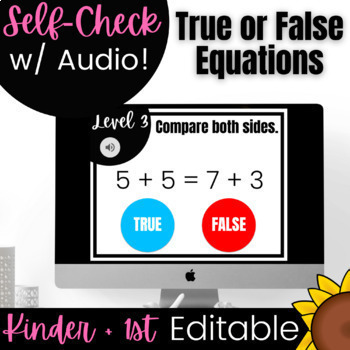First Grade True or False Equations Digital Math Activity 1.OA.7 Hybrid Learning
Miss D Gunn
293 Followers
Grade Levels
K - 2nd, Homeschool
Subjects
Resource Type
Standards
CCSS1.OA.D.7
CCSS2.OA.B.2
CCSSMP2
CCSSMP3
CCSSMP6
Formats Included
- Google Slides™
Pages
32 pages
Miss D Gunn
293 Followers

Made for Google Drive™
This resource can be used by students on Google Drive or Google Classroom. To access this resource, you’ll need to allow TPT to add it to your Google Drive. See our FAQ and Privacy Policy for more information.
What educators are saying
My students love using this resource!! Thank you so much for making it! I will continue to look for your products!!
Description
This hybrid learning must-have provides instant feedback just like Boom Cards!!! This math activity allows learners to practice Comparing Numbers within 10! This editable activity works in Google Slides and PowerPoint and may be shared in Google Classroom and Canvas.
BUNDLE SAVINGS!!!!
Kinder and 1st Grade Digital Math Activity Bundle
What's included???
- A kid-friendly overview of the standard broken into a progression scale
- Three (3) levels of questions with audio (explained below)
- Level 1- Just a number on both sides of the equal sign
- Level 2- Number on one side of the equal sign and expression on the other
- Level 3- Expression on both sides of the equal sign
- Interactive slides that provide instant verbal feedback (do not request access to edit the audio)
How to Use???
Sometimes we suffer from a creative block. Here are some ways you can use this resource...
- Lesson Engager- Present the activity to your students whole group (in-person or virtually) and allow students to answer as teams or individually.
- Centers or Stations- Have student put on their headphones and try their best to answer the problems. Provide whiteboards or manipulatives. Encourage them to write down how many times they are told to 'try again' for accountability.
- 1:1 Virtual Assessment- Present your screen to students and have them tell you the answers to click. Take note of how many times the student is told to 'try again'. Use the data to determine next steps
Standards???
- 1.OA.7 (Common Core)
- 1.OA.4.7 (Florida)
Other Resources You May Like!!!
Total Pages
32 pages
Answer Key
N/A
Teaching Duration
N/A
Last updated Mar 8th, 2021
Report this resource to TPT
Reported resources will be reviewed by our team. Report this resource to let us know if this resource violates TPT’s content guidelines.
Standards
to see state-specific standards (only available in the US).
CCSS1.OA.D.7
Understand the meaning of the equal sign, and determine if equations involving addition and subtraction are true or false. For example, which of the following equations are true and which are false? 6 = 6, 7 = 8 - 1, 5 + 2 = 2 + 5, 4 + 1 = 5 + 2.
CCSS2.OA.B.2
Fluently add and subtract within 20 using mental strategies. By end of Grade 2, know from memory all sums of two one-digit numbers.
CCSSMP2
Reason abstractly and quantitatively. Mathematically proficient students make sense of quantities and their relationships in problem situations. They bring two complementary abilities to bear on problems involving quantitative relationships: the ability to decontextualize-to abstract a given situation and represent it symbolically and manipulate the representing symbols as if they have a life of their own, without necessarily attending to their referents-and the ability to contextualize, to pause as needed during the manipulation process in order to probe into the referents for the symbols involved. Quantitative reasoning entails habits of creating a coherent representation of the problem at hand; considering the units involved; attending to the meaning of quantities, not just how to compute them; and knowing and flexibly using different properties of operations and objects.
CCSSMP3
Construct viable arguments and critique the reasoning of others. Mathematically proficient students understand and use stated assumptions, definitions, and previously established results in constructing arguments. They make conjectures and build a logical progression of statements to explore the truth of their conjectures. They are able to analyze situations by breaking them into cases, and can recognize and use counterexamples. They justify their conclusions, communicate them to others, and respond to the arguments of others. They reason inductively about data, making plausible arguments that take into account the context from which the data arose. Mathematically proficient students are also able to compare the effectiveness of two plausible arguments, distinguish correct logic or reasoning from that which is flawed, and-if there is a flaw in an argument-explain what it is. Elementary students can construct arguments using concrete referents such as objects, drawings, diagrams, and actions. Such arguments can make sense and be correct, even though they are not generalized or made formal until later grades. Later, students learn to determine domains to which an argument applies. Students at all grades can listen or read the arguments of others, decide whether they make sense, and ask useful questions to clarify or improve the arguments.
CCSSMP6
Attend to precision. Mathematically proficient students try to communicate precisely to others. They try to use clear definitions in discussion with others and in their own reasoning. They state the meaning of the symbols they choose, including using the equal sign consistently and appropriately. They are careful about specifying units of measure, and labeling axes to clarify the correspondence with quantities in a problem. They calculate accurately and efficiently, express numerical answers with a degree of precision appropriate for the problem context. In the elementary grades, students give carefully formulated explanations to each other. By the time they reach high school they have learned to examine claims and make explicit use of definitions.




